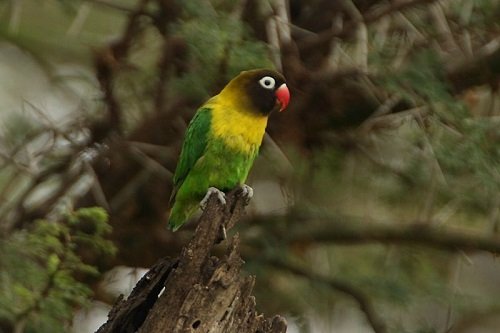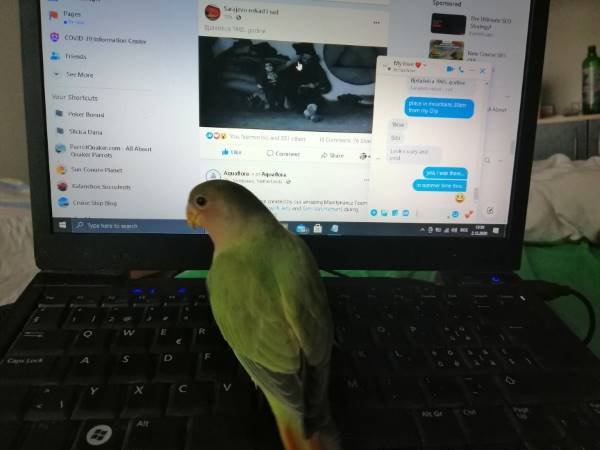Native to Northeast Tanzania, Masked Lovebird also named Yellow-collared lovebird is one of the popular parrot species. Due to their popularity, many wild species have emerged. They were discovered in the late 1800s in Tanzania, Africa. However, it wasn’t until the 1920s that Masked Lovebirds were important to the other parts of the world.
Masked Lovebird Characteristics
Size and look
Masked Lovebirds are quite small, with only 6 inches in length. Also, light, they weigh up to 50 grams. They are known for the chubby, short tails that give them a distinguishing look. Very cute, with a lively, tropical set of colors, they are eye-catching and attractive.
Masked Lovebirds are dominantly green, with a yellow collar. Breast and back are a vibrant yellow color. Their mark, as the name implies, is the black ‘’ mask’’ over the head. They have dark brown eyes and red-colored beak. Overall, Masked Lovebird is exotic in look, sweet due to the size, being completely charming, especially when taking the character into consideration.
Lifespan
Masked Lovebirds can live up to 25 years if they are provided proper care and habitat. More common for them is to achieve from 15 to 20 years in age, in the wild, but in captivity too, due to the carelessness of the owners. Anyway, it’s surprising longevity for such a small creature, right?
Intelligence
One of the perks of the huge temperament in a small body is extreme intelligence. They can be trained in a variety of tricks. Giving kisses is one of them. Lovebirds respond to your voice. When they do so, they expect you to pet them. However, intelligence doesn’t give benefits only in terms of entertainment.
They are very easy to train. Masked Lovebirds can be thought acrobatics, speech, sounds, sitting on your shoulder or hand, etc. Moreover, due to their social and affectionate nature, the training process is a rather enjoyable experience. Training, of course, requires patience. All the animals do. As the first thing to learn is to sit on your hand. This may not go as smoothly since a bird can get scared, and maybe even bite you in defense. Just don’t lose nerves. Any aggression would prolong the process.
Talking ability
Although they are not famous for their talking abilities, they can mimic various sounds from their environment, including human speech. They have a clear, distinct voice. This bird is an exceptional whistler. However, it’s not that they cannot talk. By nature, Lovebirds are calm, meaning they don’t want to talk.
Masked Lovebird Housing
Lovebirds appreciate the space. Even though they are very small, they need a lot of space to move, so they can control their energy levels. At the minimum, the cage should be 2 feet in each of the dimensions. The larger the cage, the better. In case you cannot accommodate them in a huge cage, priority should be on the length. They need space for the fly and this way they can spread their wings properly. Spacing between bars should be no more than ½ inch.
For the aggressiveness, it’s recommended to use multiple perches in the cage. If possible, place them apart from one another, experiment with the sizes as well. Since Masked Lovebirds need more of the exercise, the right cage setup would help you both find the peace at home.
Masked Lovebird Toys
To comfort their playful character, consider proving them with toys. You should get many. Not only that, but the rotation is necessary to keep them entertained. For the bird’s safety, zinc and lead should be avoided as the toy material. Any small parts, needles, or materials that are chewable shouldn’t be an option. As aggressive chewers, as they are, Masked Lovebirds could seriously injure themselves with inappropriate toys.
Another benefit is that homemade toys or left-over materials can do the work just as well. Clean cardboards, rolls of the toilet paper, shaped pasta, are just some of the fun ideas you have at home in abundance. It adds to your recycling as well.
Nest boxes should be placed up high. Lovebirds enjoy taking in the nesting some of the material. You can use the homemade nest, or buy it in the store, but if possible, make it a bit spacious.
Masked Lovebird Breeding
Hard-working as they are, Masked Lovebirds enjoy building their nests. Palm fronds, leaves, and straws they usually use to create their reproductive space. Levels of creativity vary though. Some of the birds would create high-tech nests, with tunnels or chambers.

On the other hand, some would just collect all the materials at the bottom of the box and lay their eggs on top. This is not only a hobby, however. Using different materials has biological roots. The piled leaves would increase humidity, consequently increasing the hatching rates.
They reach reproductive maturity at around a year old. When they mate with the partner, the females would lay 3 to 5 eggs, around a week after mating. Usually, only hens sit on eggs during a three weeks long incubation period.
Masked Lovebird Baby
Once the young are born, it takes around 6 to 8 weeks to become independent. Once they reach maturity, birds need to be separated from parents, so they are not subjected to parental aggression.
Females should be prohibited from breeding more than three times a year. The quality of offspring and their size reduce when overbreeding. Hen’s lifespan may be shortened as well.
When it comes to hybridization, the offspring is usually infertile and prone to various diseases. Masked Lovebirds hybridize with other lovebirds of the Agapornis genus.
One interesting fact is that these parrot bond strongly with their partners. If one of them dies, the other one shows the sign of something that looks like a depression. However, if well introduced, they could be mating with another parrot the following year.
More about Lovebird baby care.
Masked Lovebird Gender Difference
Gender differentiation is a bit challenging in Lovebirds since they are monomorphic. In look, there are no differences that could be a sign of a particular gender. However, there are some methods you can use to distinguish it easier.
Behavior can tell a lot if observed carefully. Females are likely to be building a nest, even when the pair is not formed yet. They are also louder and way more aggressive than males.
On top of that, the pelvic exam could be useful. There is a small distance of 1 to 3 mm in between the pelvic bones of a male bird, while the distance of up to 8mm is common for females.
It’s important to emphasize that the only 100% accurate result comes from the DNA test.
Mutations
There are around a dozen different color mutations available. The most popular mutations of the Masked Lovebird are lutino, albino, mauve, cobalt, and blue.
Masked Lovebird Behavior
Generally, Masked Lovebird is active, very curious, but social and affectionate. They bond with their species a lot. That’s why they like to have a companion in the cage. They need a partner and it’s a pure pleasure seeing them. The pair is even feeding each other. However, there are pros and cons to keeping a pair, depending on your lifestyle preferences.
If kept alone, they are calmer, since there is more space to enjoy. These birds are quite territorial, so living alone they would not be expressing that kind of aggression. On the other hand, they would like you to make up for the loneliness. Simply, revenge would take the form of high attention demand.
When ignored, Masked Lovebirds can get neurotic.
However, this bird is very cuddly and affectionate. If you want to commit to them, keeping a single parrot is a good choice. In case you are not that interested, or it doesn’t suit your schedule, getting them a mate in a bigger cage would keep your pet happy and healthy.
Masked Lovebird Diet
A varied and balanced diet is the key to successful Lovebird keeping. They need fruits, seeds, crops, but a portion of calcium-rich leafy vegetables such as kale and spinach for example. Taking a palette is recommended as well, due to the good minerals and vitamin composition. Occasionally changing ingredients they are fed would also benefit the overall well-being.
Masked Lovebird Health
This bird is a good choice for owners, regardless of the previous experience. One of the reasons is a strong immune system. If you take care of sunlight exposure, hygiene, proper temperature, along with a considerable amount of time spent out of the cage, your bird would have a long, happy, and healthy life.
Let’s conclude with some facts:
- They dwell in the holes in trees, rocks, or shrubs. If they inhabit rural areas, they use crevices in buildings or trees. They may be endangered in the near future.
- So far, they are classified as a sensitive species, due to the conditions in their natural habitat, such as drought. Although still stable considering Lot of African Lovebird species are endangered.
https://www.awf.org/wildlife-conservation/fischers-lovebird
Featured Photo Credit: Demetrius John Kessy from Arusha, Tanzania / CC BY (https://creativecommons.org/licenses/by/2.0)




